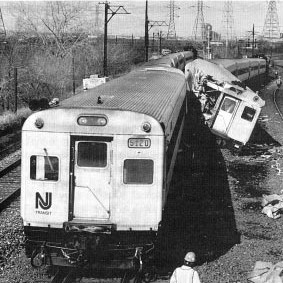
New Jersey Transit Corporation, branded as NJ Transit, and often shortened to NJT, is a state-owned public transportation system that serves the U.S. state of New Jersey, along with portions of New York State and Pennsylvania. It operates bus, light rail, and commuter rail services throughout the state, connecting to major commercial and employment centers both within the state and in the adjacent major cities of New York and Philadelphia. In 2021, the system had a ridership of 133,463,800.
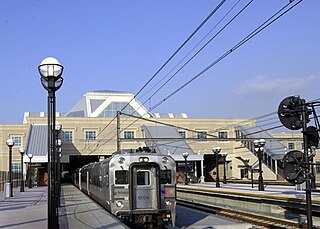
Secaucus Junction is a NJ Transit Rail Operations commuter rail hub in Secaucus, New Jersey.
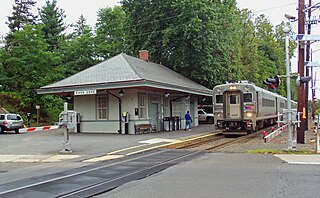
The Pascack Valley Line is a commuter rail line operated by the Hoboken Division of New Jersey Transit, in the U.S. states of New Jersey and New York. The line runs north from Hoboken Terminal, through Hudson and Bergen counties in New Jersey, and into Rockland County, New York, terminating at Spring Valley. Service within New York is operated under contract with Metro-North Railroad. The line is named for the Pascack Valley region that it passes through in northern Bergen County. The line parallels the Pascack Brook for some distance. The line is colored purple on system maps, and its symbol is a pine tree.

The Main Line is a commuter rail line owned and operated by New Jersey Transit running from Suffern, New York to Hoboken, New Jersey, in the United States. It runs daily commuter service and was once the north–south main line of the Erie Railroad. It is colored yellow on NJ Transit system maps, and its symbol is a water wheel.
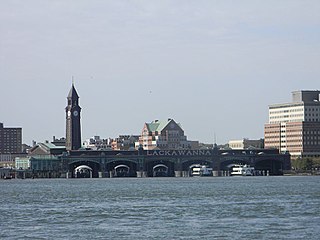
Hoboken Terminal is a commuter-oriented intermodal passenger station in Hoboken, Hudson County, New Jersey. One of the New York metropolitan area's major transportation hubs, it is served by nine NJ Transit (NJT) commuter rail lines, one Metro-North Railroad line, various NJT buses and private bus lines, the Hudson–Bergen Light Rail, the Port Authority Trans Hudson (PATH) rapid transit system, and NY Waterway-operated ferries.

Pennsylvania Station, also known as Newark Penn Station, is an intermodal passenger station in Newark, New Jersey. One of the New York metropolitan area's major transportation hubs, Newark Penn Station is served by multiple rail and bus carriers, making it the seventh busiest rail station in the United States, and the fourth busiest in the New York City metropolitan area.

NJ Transit Rail Operations is the rail division of NJ Transit. It operates commuter rail service in New Jersey, with most service centered on transportation to and from New York City, Hoboken, and Newark. NJ Transit also operates rail service in Orange and Rockland counties in New York under contract to Metro-North Railroad. The commuter rail lines saw 29,843,100 riders in 2021, making it the second-busiest commuter railroad in North America as well as the longest by route length. This does not include NJ Transit's light rail operations.

The Bergen County Line is a commuter rail line and service owned and operated by New Jersey Transit in the U.S. state of New Jersey. The line loops off the Main Line between the Meadowlands and Glen Rock, with trains continuing in either direction along the Main Line. It is colored on NJT system maps in grey, and its symbol is a cattail, which are commonly found in the Meadowlands where the line runs.

The Morristown Line is an NJ Transit commuter rail line connecting Morris and Essex counties to New York City, via either New York Penn Station or Hoboken Terminal. Out of 60 inbound and 58 outbound daily weekday trains, 28 inbound and 26 outbound Midtown Direct trains use the Kearny Connection to Penn Station; the rest go to Hoboken. Passengers can transfer at Newark Broad Street or Summit to reach the other destination. On rail system maps the line is colored dark green, and its symbol is a drum, a reference to Morristown's history during the American Revolution.

The Atlantic City Line (ACL) is a commuter rail line operated by NJ Transit (NJT) in the United States between Philadelphia, Pennsylvania and Atlantic City, New Jersey, operating along the corridor of the White Horse Pike. It runs over trackage that was controlled by both the Pennsylvania Railroad (PRR) and the Pennsylvania-Reading Seashore Lines. It shares trackage with SEPTA and Amtrak on the Northeast Corridor (NEC) until it crosses the Delaware River on its own Delair Bridge into New Jersey.
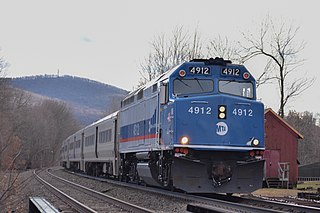
The Port Jervis Line is a predominantly single-track commuter rail line running between Suffern and Port Jervis, in the U.S. state of New York. At Suffern, the line continues south into New Jersey as NJ Transit's Main Line. The line is operated by NJ Transit Rail Operations under a working agreement with Metro-North Railroad (MNRR).
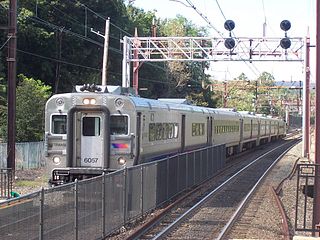
The Comet railcar is a class of locomotive-hauled railcars that was first designed in the late 1960s by Pullman-Standard as a modern commuter car for North American rail lines. Later, the Comet moniker was adopted by NJ Transit for all of its non-powered single level commuter coaches. Additional series of cars bearing the Comet name, based on the original design, have since been built by Bombardier Transportation and Alstom. The successful design was adopted by numerous commuter agencies.

The Comet V railcar is the fifth generation of the Comet railcar series. Produced by the manufacturer Alstom, the Comet V is a rather different car compared to previous models in the series. The Comet V has been in use by New York metropolitan area commuter rail operators New Jersey Transit and Metro-North since April 2002.
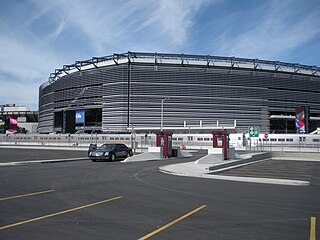
The Meadowlands Rail Line, branded as the BetMGM Meadowlands Rail Line as part of a naming rights agreement, is a rail line in New Jersey, United States, operated by NJ Transit Rail Operations (NJT). Trains run between the Meadowlands Sports Complex and Secaucus Junction, some with continuing service to Hoboken Terminal. There is a limited service on the line, with trains only operating in conjunction with major events.

Erie Railroad Signal Tower, Waldwick Yard is located in Waldwick, Bergen County, New Jersey, United States. The tower was built in 1886 and was added to the National Register of Historic Places on December 23, 1987.

The Jersey Arrow is a type of electric multiple unit (EMU) railcar developed for the Pennsylvania Railroad, and used through successive commuter operators in New Jersey, through to NJ Transit. Three models were built, but only the third model is in use today. The series is similar to SEPTA's Silverliner series, but include center doors among other differences in details.

Harmon Cove is an abandoned train station in the Harmon Cove section of Secaucus, New Jersey. The station was a former stop on the Bergen County Line which runs from Hoboken Terminal to Suffern. Train service was discontinued in 2003 when Secaucus Junction was opened.

On September 29, 2016, an NJ Transit commuter train crashed at Hoboken Terminal in Hoboken, New Jersey. The accident occurred during the morning rush hour, at one of the busiest transportation hubs in the New York metropolitan area. The events leading up to the crash remain unclear but are currently being investigated. One person died, and 114 others were injured. The train operator, who was in the cab car, was among the injured.
The 1958 Sterlington Railroad Disaster was a head-on collision by two Erie Railroad trains on August 11, 1958 at 6:47 AM killing 5 people and injuring 22 to 36. The collision occurred when the operator in the signal tower at Suffern failed to hold the westbound train No. 53 at Suffern for the eastbound No. 50 commuter train from Monroe, New York, to Hoboken, New Jersey. When he realized his error, he attempted to contact the crews via radio but was unsuccessful due to a radio dead spot. The trains impacted head-on right in front of the now abandoned Erie Railroad depot in Sterlington, New York near Sloatsburg, killing the crew of the locomotive No. 859 from train No.50 as well as two passengers and injuring the crew of the locomotive No. 1402 from the westbound train.
